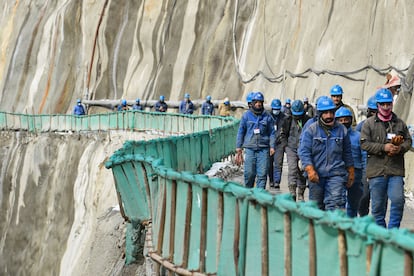Working more than 55 hours a week kills 750,000 people a year worldwide
Almost 7% of annual deaths are linked to employment, according to a report by the International Labor Organization. Mortality is higher among men than among women


An essential means of survival for the majority, every year work costs the lives of almost three million people worldwide. And of those deaths, almost 800,000 are due to working more than 55 hours a week. These are some of the main conclusions of the study A call for healthier and safer work environments, conducted by the International Labor Organization (ILO) and published on Sunday, November 26. Of the 2.96 million deaths, 2.6 million are due to diseases derived from employment such as circulatory problems, cancer, and respiratory diseases. The remaining 330,000 are related to work accidents.
However, the number of deaths at work is not growing at the same rate as the population. In other words, proportionally fewer people die due to their employment now than at the beginning of the century. While deaths resulting from work have increased by 12% from 2000 to 2019 (reference data from the ILO study), the working population has increased by 26% in the same period. “Diagnostic tools have improved substantially in the last two decades, contributing to an increase in detected cases,” the report states.
The ILO study, prepared in collaboration with the World Health Organization (WHO), relates these deaths to the most common risks at work. The one that causes the most deaths (744,942) is exposure to long working hours of over 55 hours a week. The other risks that cause the most deaths include exposure to gases and smoke (450,381), work-related injuries (363,283), exposure to asbestos (209,481), silica (42,258), substances that cause asthma (29,641), solar ultraviolet radiation (17,936), diesel engine exhaust fumes (14,728), arsenic (7,589), and nickel (7,301) according to the figures for 2016.
The study also relates these risks to the time they cost workers (disability-adjusted life years, or DALYS). The risk that costs workers the most years of life are work-related injuries (26.44 million), followed by exposure to work days of more than 55 hours (23.26), ergonomic factors (12.27), and exposure to smoke and gases (10.86). The report gives more details: “The rate of trachea, bronchus and lung cancers attributable to occupational exposure to chromium doubled between 2000 and 2016. Mesothelioma attributable to asbestos exposure has risen by 40%. The rate of non-melanoma skin cancer increased by over 37% between 2000 and 2020. On the other hand, deaths due to exposure to asthmagens [asthma triggers] and particulate matter, gases, and fumes decreased by over 20%.”
In relation to specific diseases, the ILO indicates that 32.4% of deaths at work are due to circulatory problems, 27.5% to cancer, 14.3% to respiratory diseases, 11.3% to injuries, 7.2% to infectious diseases, 3% to asthma, 2.9% to neuropsychiatric conditions, 0.95% to genitourinary problems, 0.94% to digestive diseases and 0. 15% for other reasons. According to the report, more than 13 million people around the world live with a visual impairment caused by their work.
The report highlights that employment-related deaths represent 6.7% of all deaths recorded globally. This impact differs by region. The highest proportion was in Africa (7.4%), Asia and the Pacific (7.1%), and Oceania (6.5%). The proportion is lower in Europe and America, but the ILO does not provide the specific data, nor does it provide the information by country, although it will soon distribute this information in an expansion of this study. The ILO highlights agriculture, forestry and fishing, mining, construction, and manufacturing as the most dangerous sectors, and also focuses on the informal economy, in which employees lack “a stable or regular income and adequate legal or social protections.” Likewise, it points out that there are many more work-related deaths among men (51.4 per 100,000 adults of working age) than among women (17.2 per 100,000).
In addition to the global tragedy of work-related deaths, the ILO estimates that “395 million workers worldwide suffered non-fatal workplace injuries,” the organization states.
Sign up for our weekly newsletter to get more English-language news coverage from EL PAÍS USA Edition
Tu suscripción se está usando en otro dispositivo
¿Quieres añadir otro usuario a tu suscripción?
Si continúas leyendo en este dispositivo, no se podrá leer en el otro.
FlechaTu suscripción se está usando en otro dispositivo y solo puedes acceder a EL PAÍS desde un dispositivo a la vez.
Si quieres compartir tu cuenta, cambia tu suscripción a la modalidad Premium, así podrás añadir otro usuario. Cada uno accederá con su propia cuenta de email, lo que os permitirá personalizar vuestra experiencia en EL PAÍS.
¿Tienes una suscripción de empresa? Accede aquí para contratar más cuentas.
En el caso de no saber quién está usando tu cuenta, te recomendamos cambiar tu contraseña aquí.
Si decides continuar compartiendo tu cuenta, este mensaje se mostrará en tu dispositivo y en el de la otra persona que está usando tu cuenta de forma indefinida, afectando a tu experiencia de lectura. Puedes consultar aquí los términos y condiciones de la suscripción digital.
More information
Últimas noticias
The new victims of the Republican war on Obamacare: Millions hit by soaring health insurance premiums
A country divided on migrant rights: Some US states expand protections while others restrict them
Venezuela authorizes the release of another 87 political prisoners
There is as much life left to discover on planet Earth as that which is already known
Most viewed
- David King, chemist: ‘There are scientists studying how to cool the planet; nobody should stop these experiments from happening’
- Reinhard Genzel, Nobel laureate in physics: ‘One-minute videos will never give you the truth’
- Oona Chaplin: ‘I told James Cameron that I was living in a treehouse and starting a permaculture project with a friend’
- Sinaloa Cartel war is taking its toll on Los Chapitos
- The Interoceanic Train, the Mexican alternative to the Panama Canal










































